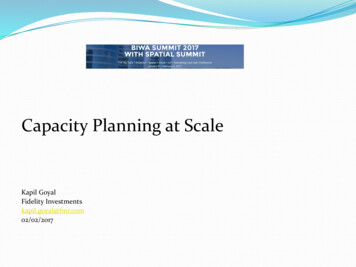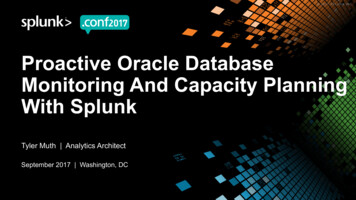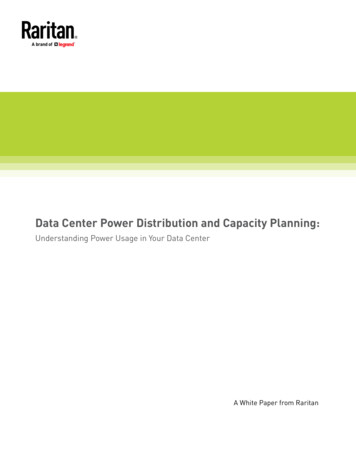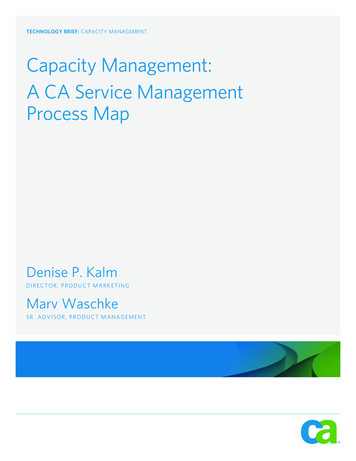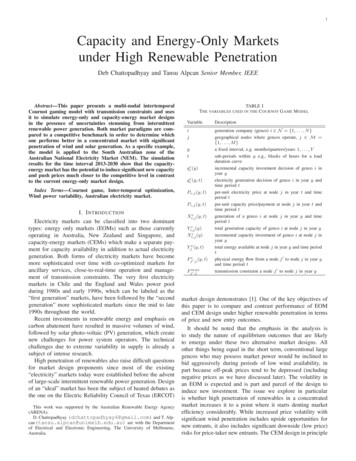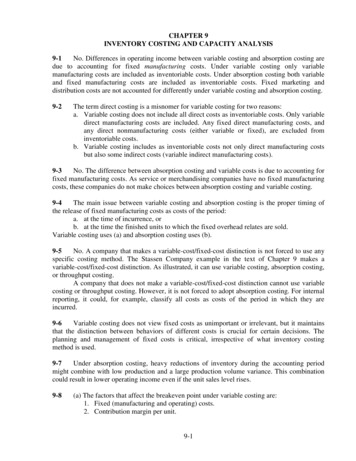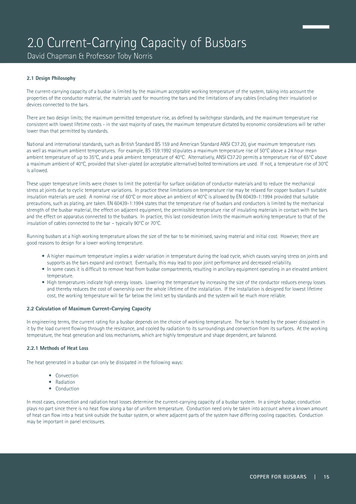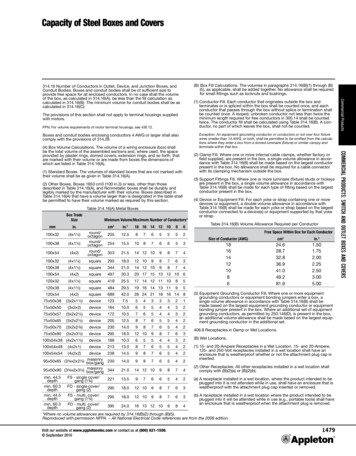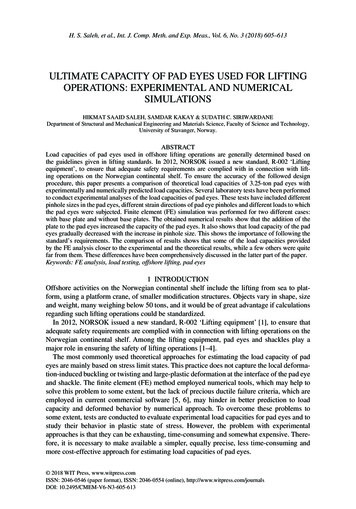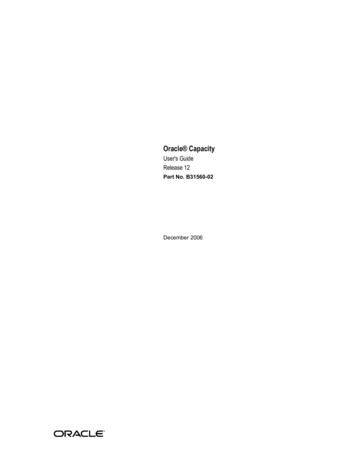
Transcription
Oracle CapacityUser's GuideRelease 12Part No. B31560-02December 2006
Oracle Capacity User's Guide, Release 12Part No. B31560-02Copyright 2000, 2006, Oracle. All rights reserved.Primary Author:Susan SapersteinThe Programs (which include both the software and documentation) contain proprietary information; theyare provided under a license agreement containing restrictions on use and disclosure and are also protectedby copyright, patent, and other intellectual and industrial property laws. Reverse engineering, disassembly, ordecompilation of the Programs, except to the extent required to obtain interoperability with otherindependently created software or as specified by law, is prohibited.The information contained in this document is subject to change without notice. If you find any problems inthe documentation, please report them to us in writing. This document is not warranted to be error-free.Except as may be expressly permitted in your license agreement for these Programs, no part of thesePrograms may be reproduced or transmitted in any form or by any means, electronic or mechanical, for anypurpose.If the Programs are delivered to the United States Government or anyone licensing or using the Programs onbehalf of the United States Government, the following notice is applicable:U.S. GOVERNMENT RIGHTSPrograms, software, databases, and related documentation and technical data delivered to U.S. Governmentcustomers are "commercial computer software" or "commercial technical data" pursuant to the applicableFederal Acquisition Regulation and agency-specific supplemental regulations. As such, use, duplication,disclosure, modification, and adaptation of the Programs, including documentation and technical data, shallbe subject to the licensing restrictions set forth in the applicable Oracle license agreement, and, to the extentapplicable, the additional rights set forth in FAR 52.227-19, Commercial Computer Software--RestrictedRights (June 1987). Oracle Corporation, 500 Oracle Parkway, Redwood City, CA 94065.The Programs are not intended for use in any nuclear, aviation, mass transit, medical, or other inherentlydangerous applications. It shall be the licensee's responsibility to take all appropriate fail-safe, backup,redundancy and other measures to ensure the safe use of such applications if the Programs are used for suchpurposes, and we disclaim liability for any damages caused by such use of the Programs.The Programs may provide links to Web sites and access to content, products, and services from third parties.Oracle is not responsible for the availability of, or any content provided on, third-party Web sites. You bear allrisks associated with the use of such content. If you choose to purchase any products or services from a thirdparty, the relationship is directly between you and the third party. Oracle is not responsible for: (a) the qualityof third-party products or services; or (b) fulfilling any of the terms of the agreement with the third party,including delivery of products or services and warranty obligations related to purchased products or services.Oracle is not responsible for any loss or damage of any sort that you may incur from dealing with any thirdparty.Oracle, JD Edwards, PeopleSoft, and Siebel are registered trademarks of Oracle Corporation and/or itsaffiliates. Other names may be trademarks of their respective owners.
ContentsSend Us Your CommentsPreface1OverviewOverview of Capacity Planning . 1-1Routing–Based and Rate–Based Capacity Planning . 1-1Set Up Oracle Applications Technology .1-32Setting UpRelated Product Setup Steps . 2-1Setting Up Underlying Oracle Applications Technology . 2-2Oracle Inventory . 2-2Oracle Bills of Material . 2-2Oracle Master Scheduling/MRP and Oracle Supply Chain Planning . 2-3Setup Flowchart . 2-3Setup Checklist . 2-4Resource Groups . 2-5Defining Resource Groups . 2-6Capacity Modifications and Simulation . 2-8Creating Simulation Sets .2-10Multi-Department Resources . 2-11Horizontal Plan Display Options . 2-11Defining CRP Display Options . 2-13Profile Options . 2-13Implementing Profile Options Summary . 2-14iii
3Rough Cut Capacity Planning (RCCP)Overview . 3-1Routing-Based RCCP . 3-2Rate-Based RCCP . 3-5Generating RCCP. 3-11Viewing RCCP. 3-11Overview of Bills of Resources . 3-16Bill of Resources Example . 3-17Usage Rate . 3-17Setback Days . 3-18Source Item . 3-20Entering Items On a Bill of Resources . 3-20Creating a Bill of Resources . 3-21Defining Bill of Resource Requirements . 3-22Loading a Bill of Resources . 3-25Viewing a Bill of Resources . 3-27Viewing Bill of Resource Items . 3-28Viewing Bill of Resource Requirements . 3-28Viewing RCCP Resources . 3-294Capacity Requirements Planning (CRP)Overview of Capacity Requirements Planning . 4-2Routing-Based CRP . 4-2Required Hours Calculation . 4-2Required Hours for Planned Orders and Repetitive Schedules . 4-3Required Hours for Discrete and Non-Standard Jobs .4-4Available Hours Calculation . 4-4Load Ratio Calculation . 4-5Rate-Based CRP . 4-6Required Rate Calculation . 4-6Maximum Hourly Rate. 4-7Load Factor . 4-9Load Rate . 4-9Available Rate Calculation . 4-10Load Ratio Calculation. 4-11Generating CRP. 4-11Viewing CRP . 4-12Resource Requirements Snapshot. 4-13Resource Requirements Snapshot Example . 4-14iv
Resource Requirements from Oracle Bills of Material . 4-15Runtime Quantity . 4-15Basis . 4-15Resource Offset . 4-16Resource Requirements from Oracle Work in Process .4-16Operation Hours Required . 4-17Operation Hours Expended . 4-17Operation Start Date . 4-175Rough Cut Capacity Planning (RCCP)Overview of Reports. 5-1Bill of Resources Report . 5-1CRP Rate-Based Report . 5-2CRP Routing-Based Report . 5-3RCCP Rate-Based Report . 5-6RCCP Routing-Based Report . 5-7ATools MenuTools Menu. A-1BWindows and Navigator PathsWindows and Navigator Paths. B-1CCharacter Mode Forms and Corresponding GUI WindowsCharacter Mode Forms and Corresponding GUI Windows. C-1GlossaryIndexv
Send Us Your CommentsOracle Capacity User's Guide, Release 12Part No. B31560-02Oracle welcomes customers' comments and suggestions on the quality and usefulness of this document.Your feedback is important, and helps us to best meet your needs as a user of our products. For example: Are the implementation steps correct and complete?Did you understand the context of the procedures?Did you find any errors in the information?Does the structure of the information help you with your tasks?Do you need different information or graphics? If so, where, and in what format?Are the examples correct? Do you need more examples?If you find any errors or have any other suggestions for improvement, then please tell us your name, thename of the company who has licensed our products, the title and part number of the documentation andthe chapter, section, and page number (if available).Note: Before sending us your comments, you might like to check that you have the latest version of thedocument and if any concerns are already addressed. To do this, access the new Applications ReleaseOnline Documentation CD available on Oracle MetaLink and www.oracle.com. It contains the mostcurrent Documentation Library plus all documents revised or released recently.Send your comments to us using the electronic mail address: appsdoc us@oracle.comPlease give your name, address, electronic mail address, and telephone number (optional).If you need assistance with Oracle software, then please contact your support representative or OracleSupport Services.If you require training or instruction in using Oracle software, then please contact your Oracle local officeand inquire about our Oracle University offerings. A list of Oracle offices is available on our Web site atwww.oracle.com.vii
PrefaceIntended AudienceWelcome to Release 12 of the Oracle Capacity User's Guide.This guide is intended for implementers, administrators, and users of Oracle CapacitySee Related Information Sources on page x for more Oracle Applications productinformation.TTY Access to Oracle Support ServicesOracle provides dedicated Text Telephone (TTY) access to Oracle Support Serviceswithin the United States of America 24 hours a day, seven days a week. For TTYsupport, call 800.446.2398.Documentation AccessibilityOur goal is to make Oracle products, services, and supporting documentationaccessible, with good usability, to the disabled community. To that end, ourdocumentation includes features that make information available to users of assistivetechnology. This documentation is available in HTML format, and contains markup tofacilitate access by the disabled community. Accessibility standards will continue toevolve over time, and Oracle is actively engaged with other market-leading technologyvendors to address technical obstacles so that our documentation can be accessible to allof our customers. For more information, visit the Oracle Accessibility Program Web siteat http://www.oracle.com/accessibility/ .Accessibility of Code Examples in DocumentationScreen readers may not always correctly read the code examples in this document. Theconventions for writing code require that closing braces should appear on an otherwiseix
empty line; however, some screen readers may not always read a line of text thatconsists solely of a bracket or brace.Accessibility of Links to External Web Sites in DocumentationThis documentation may contain links to Web sites of other companies or organizationsthat Oracle does not own or control. Oracle neither evaluates nor makes anyrepresentations regarding the accessibility of these Web sites.Structure1 Overview2 Setting Up3 Rough Cut Capacity Planning (RCCP)4 Capacity Requirements Planning (CRP)5 Rough Cut Capacity Planning (RCCP)A Tools MenuB Windows and Navigator PathsC Character Mode Forms and Corresponding GUI WindowsGlossaryRelated Information SourcesOracle Capacity shares business and setup information with other Oracle Applicationsproducts. Therefore, refer to other user guides when you set up and use OracleCapacity.User Guides Related to All Products: Oracle Applications User Guide Oracle Applications Developer's Guide Oracle Applications User Interface StandardsUser Guides Related to Oracle Capacity:x Oracle Advanced Supply Chain Planning and Oracle Global ATP Server User's Guide Oracle Applications Flexfields Guide Oracle Bills of Material User's Guide Oracle Business Intelligence System Implementation Guide Oracle Flow Manufacturing User's Guide Oracle Inventory User's Guide
Oracle Master Scheduling/MRP and Oracle Supply Chain Planning User's Guide Oracle Work in Process User's GuideInstallation and System Administration Guides: Oracle Applications Concepts Installing Oracle Applications Upgrading Oracle Applications Using the AD Utilities Oracle Applications Product Update Notes Oracle Applications System Administrator's GuideIntegration RepositoryThe Oracle Integration Repository is a compilation of information about the serviceendpoints exposed by the Oracle E-Business Suite of applications. It provides acomplete catalog of Oracle E-Business Suite's business service interfaces. The tool letsusers easily discover and deploy the appropriate business service interface forintegration with any system, application, or business partner.The Oracle Integration Repository is shipped as part of the E-Business Suite. As yourinstance is patched, the repository is automatically updated with content appropriatefor the precise revisions of interfaces in your environment.Do Not Use Database Tools to Modify Oracle Applications DataOracle STRONGLY RECOMMENDS that you never use SQL*Plus, Oracle DataBrowser, database triggers, or any other tool to modify Oracle Applications data unlessotherwise instructed.Oracle provides powerful tools you can use to create, store, change, retrieve, andmaintain information in an Oracle database. But if you use Oracle tools such asSQL*Plus to modify Oracle Applications data, you risk destroying the integrity of yourdata and you lose the ability to audit changes to your data.Because Oracle Applications tables are interrelated, any change you make using anOracle Applications form can update many tables at once. But when you modify OracleApplications data using anything other than Oracle Applications, you may change arow in one table without making corresponding changes in related tables. If your tablesget out of synchronization with each other, you risk retrieving erroneous informationand you risk unpredictable results throughout Oracle Applications.When you use Oracle Applications to modify your data, Oracle Applicationsxi
automatically checks that your changes are valid. Oracle Applications also keeps trackof who changes information. If you enter information into database tables usingdatabase tools, you may store invalid information. You also lose th
4 Capacity Requirements Planning (CRP) 5 Rough Cut Capacity Planning (RCCP) A Tools Menu B Windows and Navigator Paths C Character Mode Forms and Corresponding GUI Windows Glossary Related Information Sources Oracle Capacity shares business and setup information with other Oracle Applications
